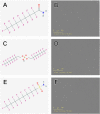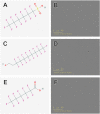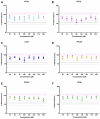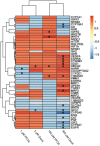A High-Throughput Toxicity Screen of 42 Per- and Polyfluoroalkyl Substances (PFAS) and Functional Assessment of Migration and Gene Expression in Human Placental Trophoblast Cells
- PMID: 35548680
- PMCID: PMC9081605
- DOI: 10.3389/ftox.2022.881347
A High-Throughput Toxicity Screen of 42 Per- and Polyfluoroalkyl Substances (PFAS) and Functional Assessment of Migration and Gene Expression in Human Placental Trophoblast Cells
Abstract
Per- and polyfluoroalkyl substances (PFAS) have become ubiquitous environmental contaminants that have been associated with adverse pregnancy outcomes in women and experimental research models. Adverse developmental and reproductive outcomes have been investigated for relatively few PFAS, and such studies are not scalable to address the thousands of unique chemical structures. As the placenta has been reported as a PFAS target tissue, the human placental trophoblast JEG-3 cell line was employed in a high-throughput toxicity screen (HTTS) to evaluate the effects of 42 unique PFAS on viability, proliferation, and mitochondrial membrane potential (MMP). HTTS concentration-response curve fitting determined EC50 values for 79% of tested compounds for at least one of the three endpoints. Trophoblast migratory potential was evaluated for a subset of six prioritized PFAS using a scratch wound assay. Migration, measured as the percent of wound closure after 72 h, was most severely inhibited by exposure to 100 µM perfluorooctanoic acid (PFOA; 72% closure), perfluorooctanesulfonic acid (PFOS; 57% closure), or ammonium perfluoro-2-methyl-3-oxahexanoate (GenX; 79% closure). PFOA and GenX were subsequently evaluated for disrupted expression of 46 genes reported to be vital to trophoblast health. Disrupted regulation of oxidative stress was suggested by altered expression of GPEX1 (300 µM GenX and 3 µM GenX), GPER1 (300 µM GenX), and SOD1 and altered cellular response to xenobiotic stress was indicated by upregulation of the placental efflux transporter, ABCG2 (300 µM GenX, 3 µM GenX, and 100 µM PFOA). These findings suggest the placenta is potentially a direct target of PFAS exposure and indicate that trophoblast cell gene expression and function are disrupted at PFAS levels well below the calculated cytotoxicity threshold (EC50). Future work is needed to determine the mechanism(s) of action of PFAS towards placental trophoblasts.
Keywords: In Vitro toxicity; PFAS; alternative methods; high-throughput (HT) testing; trophoblasts.
Copyright © 2022 Blake, Rickard and Fenton.
Conflict of interest statement
The authors declare that the research was conducted in the absence of any commercial or financial relationships that could be construed as a potential conflict of interest.
Figures






Similar articles
-
An assessment of serum-dependent impacts on intracellular accumulation and genomic response of per- and polyfluoroalkyl substances in a placental trophoblast model.Environ Toxicol. 2020 Dec;35(12):1395-1405. doi: 10.1002/tox.23004. Epub 2020 Aug 13. Environ Toxicol. 2020. PMID: 32790152 Free PMC article.
-
Per- and Polyfluoroalkyl Substances Differentially Inhibit Placental Trophoblast Migration and Invasion In Vitro.Toxicol Sci. 2020 Jun 1;175(2):210-219. doi: 10.1093/toxsci/kfaa043. Toxicol Sci. 2020. PMID: 32219433 Free PMC article.
-
Comparison of sub-lethal metabolic perturbations of select legacy and novel perfluorinated alkyl substances (PFAS) in Daphnia magna.Environ Res. 2022 Sep;212(Pt D):113582. doi: 10.1016/j.envres.2022.113582. Epub 2022 Jun 1. Environ Res. 2022. PMID: 35661729
-
Epigenetic changes by per- and polyfluoroalkyl substances (PFAS).Environ Pollut. 2021 Jun 15;279:116929. doi: 10.1016/j.envpol.2021.116929. Epub 2021 Mar 15. Environ Pollut. 2021. PMID: 33751946 Review.
-
Application of the Key Characteristics of Carcinogens to Per and Polyfluoroalkyl Substances.Int J Environ Res Public Health. 2020 Mar 4;17(5):1668. doi: 10.3390/ijerph17051668. Int J Environ Res Public Health. 2020. PMID: 32143379 Free PMC article. Review.
Cited by
-
Prenatal per- and polyfluoroalkyl substance exposures and DNA methylation among newborns in the Environmental influences on Child Health Outcomes program.Environ Epigenet. 2025 Apr 24;11(1):dvaf010. doi: 10.1093/eep/dvaf010. eCollection 2025. Environ Epigenet. 2025. PMID: 40401168 Free PMC article.
-
PFOS Impairs Mitochondrial Biogenesis and Dynamics and Reduces Oxygen Consumption in Human Trophoblasts.J Environ Sci Public Health. 2023;7(4):164-175. Epub 2023 Oct 10. J Environ Sci Public Health. 2023. PMID: 37920428 Free PMC article.
-
Perfluorooctanoic acid induces transcriptomic alterations in second trimester human cytotrophoblasts.Toxicol Sci. 2023 Nov 28;196(2):187-199. doi: 10.1093/toxsci/kfad097. Toxicol Sci. 2023. PMID: 37738295 Free PMC article.
-
Current approaches and advances in placental toxicology.Trends Endocrinol Metab. 2025 Jun 4:S1043-2760(25)00100-6. doi: 10.1016/j.tem.2025.05.001. Online ahead of print. Trends Endocrinol Metab. 2025. PMID: 40473500 Review.
-
Per- and polyfluoroalkyl substances (PFAS) and hypertensive disorders of Pregnancy- integration of epidemiological and mechanistic evidence.Reprod Toxicol. 2024 Dec;130:108702. doi: 10.1016/j.reprotox.2024.108702. Epub 2024 Aug 31. Reprod Toxicol. 2024. PMID: 39222887 Review.
References
-
- Bangma J., Eaves L. A., Oldenburg K., Reiner J. L., Manuck T., Fry R. C. (2020a). Identifying Risk Factors for Levels of Per- and Polyfluoroalkyl Substances (PFAS) in the Placenta in a High-Risk Pregnancy Cohort in North Carolina. Environ. Sci. Technol. 54 (13), 8158–8166. 10.1021/acs.est.9b07102 - DOI - PMC - PubMed
-
- Bangma J., Szilagyi J., Blake B. E., Plazas C., Kepper S., Fenton S. E., et al. (2020b). An Assessment of Serum‐dependent Impacts on Intracellular Accumulation and Genomic Response of Per‐ and Polyfluoroalkyl Substances in a Placental Trophoblast Model. Environ. Toxicol. 35 (12), 1395–1405. 10.1002/tox.23004 - DOI - PMC - PubMed
LinkOut - more resources
Full Text Sources
Research Materials
Miscellaneous

